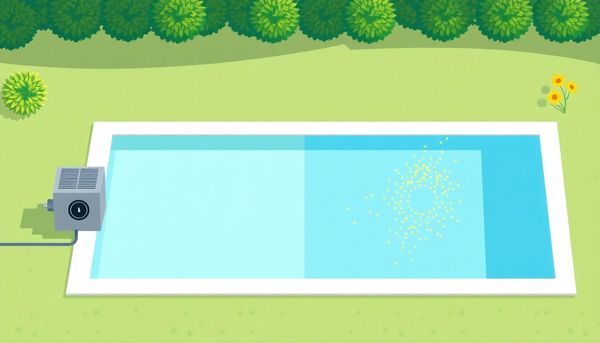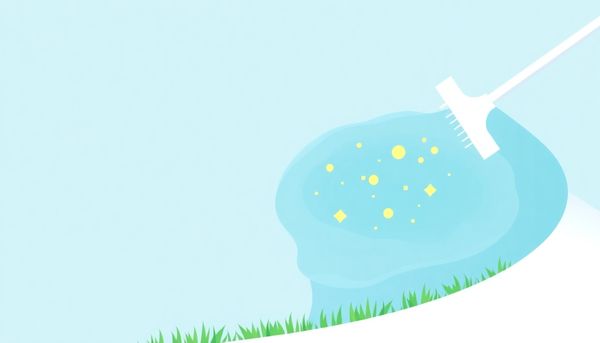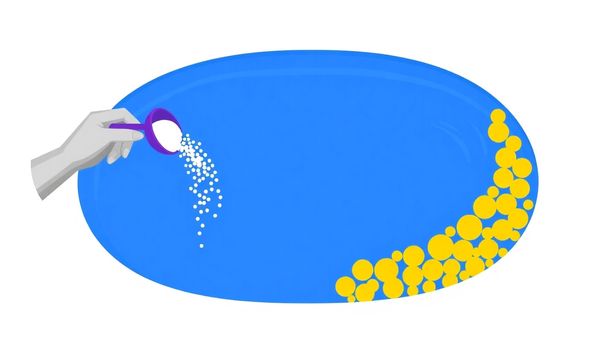How to Keep Your Pool Pollen-Free This Spring
December 18th, 2024
December 18th, 2024
As spring unfurls its colorful tapestry, pollen becomes an uninvited guest in many pools. This fine yellow dust can transform a crystal-clear oasis into a murky mystery, much to the dismay of pool owners everywhere. One sunny afternoon last spring, I gazed at my pool, expecting its usual inviting sparkle, only to find a shimmering layer of pollen stubbornly clinging to the surface. Frustration bubbled up as I realized that this was nature's little hiccup that I needed to address.
Pollen is more than just a seasonal nuisance; it can affect water quality and pool filtration systems. Not only does it cloud the water, but it can also contribute to algae growth if left unchecked. As I stood by my pool, skimmer net in hand, I realized that tackling this problem efficiently required more than just a quick skim. It was time to develop an effective strategy that transformed my frustration into a systematic approach.
Understanding the intricacies of pool maintenance is crucial for every pool owner, especially when faced with seasonal challenges like pollen. Though it might seem daunting at first, removing pollen from your pool isn’t an insurmountable task. With a little patience and the right steps, you can restore your pool’s pristine condition without breaking a sweat. Let's embark on this journey together, turning what seems like a springtime catastrophe into an opportunity for flawless pool upkeep.

Waking up to find a hazy yellow film on your pool can be frustrating, especially when you're eager for a quick dip. Identifying whether you're dealing with pollen or something more sinister, like mustard algae, is the first step towards restoring that crystal clarity. A close inspection is key: pollen tends to drift and cluster on the water’s surface, making it relatively easy for your pool’s filtration system to capture it. Algae, on the other hand, stubbornly clings to the pool's sides and base, refusing to budge without a fight.
Remember the last time you noticed a similar yellow tinge on your car or porch during spring? That same fine pollen can easily find its way into your pool, carried by the wind from nearby plants, trees, and flowers. It’s not selective about where it lands, and your pool is no exception. Luckily, recognizing pollen is straightforward once you know what to look for.
Furthermore, consider the timing of the pollen’s appearance. During peak seasons, when trees and flowers are in full bloom, there's an uptick in pollen count. Check local forecasts or use pollen tracking apps to stay informed. Armed with this knowledge, you can prepare to tackle pollen promptly, minimizing its impact on your swimming sanctuary. Your pool might share its space with pollen for a while, but that doesn't mean you can't reclaim it swiftly.
Waking up to find a yellow hue in your pool can be bewildering. You're left to decipher: is it pollen or the notorious mustard algae? Though they share a similar palette, their behavior reveals their identity. Imagine standing at the pool's edge, armed with only your knowledge to identify the culprit. Here's how to distinguish between these two puzzling pool invaders.
Start by observing where the yellow substance settles. Pollen typically floats lazily on the water's surface, forming a thin, dusty layer. It drifts along, awaiting a gust of wind or the pool's filtration system to whisk it away. If you peek into the filter basket and notice it's catching these fine particles, you're likely dealing with pollen.
In contrast, mustard algae is more insidious. It clings stubbornly to the pool walls and floor, refusing to budge despite the filter’s best efforts. Algae often appears in shaded areas where sunlight doesn’t reach, and it holds fast, requiring a bit more elbow grease to remove. It’s like that persistent stain that just won’t wash out, a real test of your pool maintenance mettle.
Experience may have taught me that a net won't suffice for algae; you'll need to scrub it away and use a targeted algaecide. Meanwhile, pollen's more forgiving, often needing just a good skim and a boost from the filter. By learning these quirks, you'll swiftly master pollen and algae identification, ensuring your pool remains a pristine oasis.
Sunlight dances on the surface of your pool, but there's a sinister undercurrent below—pollen, your uninvited guest. A robust filtration system stands as your trusty ally against this yellow intruder. While manual skimming does a commendable job, consistent use of your pool filter can significantly lighten your load.
Instead of sporadically flipping the switch on your pool filter, consider setting it to run during those peak pollen hours—early morning and late afternoon. This strategy captures the fine particles before they settle, curbing the pollen problem at its roots. My neighbor once shared how their pool transformed from a pollen pond to a crystal-clear oasis simply by extending their filtration schedule by a few extra hours each day.
When dealing with stubborn pollen that slips through the filter’s grasp, a clarifier can be your secret weapon. This magical solution helps bind the pollen particles, making them sizable enough for your filter to capture. Diligence is key; regular maintenance ensures your filter functions at its best, keeping your pool inviting and pollen-free. It's like giving your pool a breath of fresh air, ensuring that each dip is refreshing, without turning into an unexpected sneeze fest. Embrace the power of effective filtering, and let your pool be the serene retreat it was always meant to be.
Every pool owner knows the satisfying ritual of skimming, but when pollen season rolls around, it's more than just a routine chore. Armed with a skimmer, one can swiftly transform a pollen-laden pool into a welcoming oasis. The key? Consistency and technique. Start by equipping yourself with a skimmer that boasts a fine mesh net, one capable of capturing even the tiniest pollen particles. A regular leaf skimmer might not cut it; those sneaky yellow specks can slip right through, leaving you frustrated and your pool still murky.
Mornings often present the best opportunity for a thorough skimming session. The calm, still water makes it easier to spot and scoop up pollen that has floated to the surface overnight. It's akin to a morning meditation, where each swipe of the net brings a bit more clarity to your day—and your pool. Repeating this process throughout the day, especially during peak pollen months, can make a world of difference.
A seasoned pool owner once shared that a gentle, zig-zag pattern works wonders, ensuring no section of the pool is overlooked. This method doesn't just clear pollen but also gives you the chance to connect with your pool, understanding its unique rhythms and needs. Embrace this skimming routine, and soon, you'll find that removing pollen is less of a task and more of a satisfying ritual.

The pool filter, that trusty, often unsung hero of pool maintenance, can become your best ally when battling the relentless onslaught of pollen. Operating as the frontline soldier in this seasonal skirmish, the filter captures much of the pollen that drifts into your pool, preventing it from becoming a murky mess.
Think of it like this: you wouldn't go into battle without your armor, and your pool shouldn’t face pollen season without its filter running at full strength. During peak pollen periods, consider running your filter longer than usual. Extending the filtration cycle increases the chances of catching even the tiniest pollen particles that might otherwise escape notice.
One of my neighbors swears by running their filter for 12 hours a day during the heavy pollen season, claiming it dramatically reduces the time they spend skimming. Sure, this might nudge your electricity bill upwards, but the payoff is a cleaner pool and fewer manual cleanups. And who can put a price on lounging by a pool that’s not coated in yellow dust?
If you find your filter struggling, it might be time to give it a little TLC—a backwash or a cartridge replacement can reinvigorate its effectiveness. Remember, a well-maintained filter is the backbone of a pristine pool, and during pollen season, it can spare you hours of unnecessary toil.
Waking up to find a yellowish film on your once-pristine pool can be a bit of a shock. It's easy to mistake this golden haze for mustard algae, especially if you're new to pool maintenance. But before jumping to conclusions, it's crucial to identify whether you're dealing with pollen or something else.
Pollen has a distinct way of making its presence known. Unlike algae, which tends to cling stubbornly to pool walls and floor, pollen usually drifts languidly on the surface of the water. If your pool's filtration system has managed to capture some of it, you're likely facing a pollen invasion. Observing the way it collects and floats can save you from unnecessary treatments aimed at algae.
My neighbor once spent an entire weekend battling what he thought was mustard algae, only to discover it was merely pollen. A quick check of the pool's skimmer basket confirmed it—a fine yellow dust was nestled there, waiting for a windy day to return.
Knowing that pollen is the culprit makes the removal process straightforward. The key is recognizing that unlike algae, pollen won't attach itself to the pool surfaces stubbornly. Instead, it drifts, gathers, and often gets trapped by your pool's diligent filter. Identifying it correctly is your first step towards reclaiming your pool’s sparkle, without unnecessary fuss or expense.
Skimming your pool might not be the most glamorous task, but mastering the technique can make all the difference when it comes to battling pollen. When morning light hits your pool, that’s your cue to grab your trusty skimmer. Opt for one with a fine mesh net—trust me, it's a game changer. The fine mesh ensures even the smallest particles get trapped, which is essential during peak pollen seasons.
Begin by moving your skimmer smoothly across the surface in long, overlapping strokes. It’s like sweeping a floor, except your floor is the water and your broom is a net. Pay extra attention to corners and edges where pollen tends to gather unnoticed. During particularly heavy pollen days, you might need to skim more than once; consider it an opportunity to enjoy some early morning sunshine.
A skimmer alone won't catch every speck, so consider enlisting some backup. After skimming, run your pool's filtration system to capture the finer particles. It’s a one-two punch that will keep your pool clear and inviting. The extra effort not only enhances the look of your pool but also cuts down on potential irritants for swimmers.
Think of skimming as a form of mindfulness—a simple, meditative task that leads to tangible rewards: clearer water and a more serene swimming experience. With practice, this routine becomes as natural as sipping lemonade on a hot summer day.
When pollen season turns your pool into a yellow-tinged teacup, optimizing filtration efficiency becomes crucial. The heart of your pool’s defense, the filtration system deserves a little attention to perform at its best. First, ensure the filter is clean; a clogged filter is like a sieve with too much gunk—useless at trapping tiny particles. Regular backwashing or cleaning is key, especially during those peak pollen days.
Consider upgrading your filter media. If you’re using a sand filter, swapping it out for glass media could provide better filtration, capturing finer particles. For cartridge filters, inspect the cartridges and replace any that look worn. A well-maintained filter works wonders in reducing pollen buildup.
Next, adjust the filtration cycle. While running the filter continuously might seem like overkill, increasing the run time during heavy pollen days can make a noticeable difference. This tactic allows the system to catch more of those pesky particles before they settle.
As a final touch, adding a flocculant or clarifier to the water helps tiny pollen particles clump together, making them easier for your filter to capture. It’s a simple addition that can significantly boost your filtration system’s effectiveness. With these tweaks, your pool will stand resilient against the pollen invasion, leaving you more time to enjoy that crystal-clear water.

A shimmering pool can quickly lose its sparkle when pollen begins to accumulate, creating an unsightly film across the surface. Ensuring your pool remains inviting during pollen-heavy months begins with an indispensable tool: the fine-mesh skimmer. Unlike regular skimmers that can let smaller particles slip through, a fine-mesh skimmer is your best ally in tackling that stubborn yellow haze.
One brisk morning, after noticing a golden dust settling on my pool, I reached for my trusty skimmer. It was a newfound appreciation for this tool as it deftly captured floating pollen. Having a skimmer with a fine-mesh head is crucial because pollen grains are minuscule and can easily evade generic nets. As you glide the skimmer across the surface, you'll notice how efficiently it collects not just pollen, but also other small debris that may have gathered overnight.
Using this skimmer daily, especially during peak pollen season, minimizes the time and effort needed to maintain your pool’s clarity. It’s a simple routine—one that can be as quick as your morning coffee break. And though it can’t capture every speck, it dramatically reduces the pollen load, allowing your pool filter to manage the rest more effectively.
Incorporate this habit, and you’ll find your pool not only looks clearer but also requires less intensive maintenance down the line. Just as gardeners cherish their tools, pool owners should embrace the fine-mesh skimmer—it’s the unsung hero of pristine waters.
Waking up to find your pool adorned with a mysterious golden hue isn't exactly the morning surprise anyone hopes for. Determining whether this unwelcome guest is indeed pollen or something more stubborn, like mustard algae, is the first step in reclaiming your sparkling oasis. Mistaking one for the other can lead to unnecessary efforts and wasted resources.
Pollen usually drifts and dances across the water surface, occasionally snagged by the filter, acting like it belongs there. Meanwhile, mustard algae prefers a more stubborn approach, clinging relentlessly to the pool walls and eluding filtration systems. Observing where the yellowish tint settles is crucial. If it’s floating gracefully on the surface, you’re likely dealing with pollen. However, if it clings to the pool’s interior like unwelcome wallpaper, algae might be your culprit.
This distinction is not just about avoiding a cleaning mishap. Understanding the behavior of these substances ensures you target the right enemy with the appropriate arsenal. It's like knowing when to bring a broom to a dust fight rather than a mop. With this knowledge, you can deploy your pool’s filtration system effectively and engage in timely skimming, ensuring your battle against pollen remains swift and uncomplicated. It’s the clarity that keeps your pool not just a sight for sore eyes, but a sanctuary away from the chaos of pollen season.
Waking up to a pool sprinkled with pollen can feel like discovering crumbs in your freshly made bed. It's an unwelcome sight, but one that's easily managed with a trusty fine-mesh skimmer. This tool becomes your best friend during pollen season, adept at whisking away those pesky yellow particles that bob across the water’s surface.
The magic of a fine-mesh skimmer lies in its ability to trap even the smallest bits of debris. The key is to choose one with a net fine enough to capture pollen, yet sturdy enough to handle heavier debris. Each morning, before the sun intensifies, take a moment to glide the skimmer across the pool's surface. It’s surprisingly therapeutic, like combing through a sandy beach for treasures, and it ensures your pool sparkles under the sun.
During peak pollen season, you might find yourself repeating this ritual in the afternoon or after a particularly windy day. The skimmer not only removes pollen but also captures fallen leaves and other debris, keeping your pool pristine. While it may seem like a chore, think of it as a daily meditation session, a chance to disconnect and focus solely on the rhythmic motion of the water.
Investing in a fine-mesh skimmer with a durable head can save you from frequent replacements and reduce frustration. Consider it an essential ally in your pool maintenance arsenal, giving you peace of mind and a clearer swim.
When that sneaky yellow haze starts to float on your pristine pool, the filtration system becomes your unsung hero. While it might not wear a cape, it plays a crucial role in keeping that pesky pollen at bay. Start by running your pool filter longer than usual during high pollen seasons—this dramatically boosts your defense strategy. It may nudge up your energy bill, but think of it as a small price for the crystal-clear water you deserve.
Instead of a standard pool filter, consider upgrading to a finer filter media, like diatomaceous earth (DE) or a cartridge filter with a smaller micron rating. These options are excellent at trapping finer particles that might slip through sand filters. After all, the goal is to make pollen disappear, not relocate it.
Enhance the efficiency further by maintaining your filter in top condition. Regular backwashing and timely replacements ensure it performs at its peak. You wouldn't let your car run on flat tires; treat your filtration system with the same care. And remember, if pollen seems relentless, using a clarifier can work wonders. This helps coagulate the tiny particles into larger clumps, making it easier for your filter to snatch them up.
Keeping a vigilant eye on your filtration routine not only saves you hours of manual labor but also keeps your pool an inviting oasis, rather than a pollen playground.

The air is thick with the scent of spring, and alongside it, a sprinkle of pollen that loves to find its way into every nook and cranny—especially your pool. Tackling this dusty invader might sound daunting, but a simple trick can make all the difference. Enter aluminum sulfate, your new best friend for a sparkling pool.
This compound acts like a magnet for pollen particles. When added to pool water, it draws these microscopic floaters into clumps large enough for your pool’s filtration system to capture effectively. The beauty of aluminum sulfate lies in its ability to transform the invisible into the manageable, ensuring your pool remains a sanctuary of clarity.
Consider the process akin to a dance: you sprinkle the aluminum sulfate, and it gracefully binds with the pollen, creating clusters that waltz their way into your skimmer basket. It's a low-effort, high-impact solution that saves you from the repetitive chore of endless skimming. This method works wonders during peak pollen seasons, reducing the burden on your filter and preserving its longevity.
A friend of mine once lamented about her own pollen woes. After a session of poolside brainstorming, the solution was clear. She thanked me profusely after seeing the miraculous transformation the next morning—a serene, clear pool greeting her at dawn. With aluminum sulfate, you're not just maintaining a pool; you're ensuring the pristine oasis you envisioned.
There’s something almost magical about stepping outside to see your backyard retreat reflecting the morning sun. But when a mysterious yellow hue lurks on the water's surface, it's time to play detective. Could it be pollen, or is it the sneaky mustard algae making a cameo? Distinguishing between these two pool invaders can save you both time and hassle in maintenance.
Pollen, unlike its stubborn counterpart, tends to float gracefully on the water's surface, occasionally hitching a ride through your filtration system. It’s a seasonal guest, often visiting when trees and flowers are in full bloom. On the other hand, mustard algae prefers to cling stubbornly to the pool’s sides and bottom, resisting typical filtration efforts. Spotting this difference is crucial—misidentifying algae as pollen can lead to ineffective clean-up efforts and a recurring problem.
Once you suspect pollen, take a stroll around your pool area. Are there trees releasing their golden dust nearby, or have recent breezes carried this nuisance from afar? If you notice pollen accumulation matching the tell-tale signs—floating specks that gather in clusters—then you’re likely dealing with Mother Nature's seasonal calling card.
Armed with this knowledge, you can proceed confidently with the right approach to reclaim your pool's pristine appearance. Not only does proper identification streamline the cleaning process, but it also means less time worrying and more time enjoying your oasis.
As you sip your morning coffee, the sight of a pollen-dusted pool might not be the most delightful view. But fear not—your trusty skimmer is ready to tackle the task. Think of the skimmer as your early morning ally, its fine mesh deftly collecting the pollen that settled overnight. Unlike leaves or larger debris, pollen requires a bit more finesse, and that's where the skimmer shines. Simply glide it across the water’s surface, and you'll be amazed at how much easier your day just became.
Each pass with the skimmer is a small victory against the relentless invasion of pollen, and maintaining a regular schedule is key. On particularly breezy days, you might notice the pollen accumulating faster, requiring an extra skimming session in the afternoon. It may sound like a chore, but consider it as a moment of zen—a chance to enjoy the tranquility of your pool area while keeping nature's nuisances at bay.
For those especially persistent specks that slip through, using a skimmer with a high-quality mesh is essential. It’s not just about getting the job done but doing it efficiently. Investing in a sturdy skimmer with a lifetime guarantee ensures that you have a reliable partner in your pool maintenance routine, year after year. With this tool in hand, your pool can remain an oasis, free from the assault of pollen.
Among the tools designed to tackle stubborn pollen in your pool, aluminum sulfate stands out like a secret weapon in your cleaning arsenal. A little chemistry lesson: aluminum sulfate acts as a coagulant. When introduced to pool water, it encourages microscopic pollen particles to bind together, forming larger clumps that are easier to trap and remove. This method can be a game-changer, especially during peak pollen season when it feels like you’re fighting a losing battle.
I remember the first time I tried this trick. My backyard pool had turned into what looked like a giant pollen-infused latte. A friend recommended aluminum sulfate, and with a skeptical heart, I sprinkled it over the water. Hours later, I watched in awe as the once-elusive particles had gathered together, floating like soft clouds on the surface, ready to be skimmed away.
To apply, evenly distribute the aluminum sulfate across the pool’s surface. Mix it into a bucket of pool water first to ensure even distribution, then move around the perimeter of your pool for comprehensive coverage. Let the magic brew for several hours, then run your pool’s filtration system to help capture the newly-formed clumps. This simple substance can save you from hours of skimming frustration and bring back that sparkling allure of your oasis. Keep in mind, though, moderation is key—too much can disrupt the pool’s pH balance. With a careful hand, your pool will soon be ready for a pollen-free splash.
Ever notice your pool's sparkling charm dull after a pollen invasion? Ensuring an extra layer of cleanliness, shocking your pool can be a game-changer. This isn't about giving your pool a surprise—it’s about restoring its pristine condition by tackling what the naked eye might miss.
Shocking the pool involves introducing a potent dose of chlorine or non-chlorine chemicals to eliminate organic contaminants and microorganisms that thrive alongside pollen. While pollen itself may not be eradicated by shock, the bacteria and algae that decide to make your pool their vacation spot, feeding on pollen, won’t stand a chance. By targeting these unwanted guests, you're preventing potential problems before they start, ensuring your pool stays a safe oasis.
Consider doing this treatment at twilight. As the sun sets, the chlorine doesn't have to compete with UV rays, allowing it to work more efficiently. A good night’s rest for your pool means you’ll wake to clearer waters. The morning after, take a leisurely stroll around your pool with a skimmer in hand, removing the remnants of pollen and any other debris that might have been stirred up.
It’s a bit like giving your pool a refreshing spa treatment. The result? A cleaner, more inviting pool that’s ready for cannonballs rather than sneezes. Whether you're hosting a summer barbecue or simply enjoying a quiet swim, ensuring your pool is shock-ready can save time and hassle in the long run.
When all other methods seem insufficient, grabbing the pool vacuum might be your saving grace. It’s akin to pulling out the big guns when everything else falls short. Vacuuming becomes necessary when the pollen has made itself at home, stubbornly refusing to leave despite your best efforts with skimmers and filters. This isn’t just any cleaning task; it’s a commitment to restoring clarity to your once sparkling oasis.
Consider this: A manual vacuuming session might feel like a workout, but the results are worth the sweat. Unlike automatic pool cleaners, manual vacuums give you precision control. As you guide the vacuum head meticulously over the floor and corners of the pool, you can be sure no pollen particle will escape your reach. It's like giving your pool a deep scrub with a fine-tooth comb.
However, this step isn’t without its trade-offs. You’ll notice a slight uptick in your utility bills due to the power needed to operate the vacuum and the extra water required to refill the pool afterward. Despite these costs, the relief of diving into a pollen-free pool can make it all worthwhile. Just imagine relaxing poolside, drink in hand, knowing the water is as clear as it looks.
So, as you prepare for another season of pollen, remember that a vacuum could be your ace in the hole. It’s the final push to reclaim your pool’s pristine beauty, ensuring every swim is as enjoyable as the first.

Spring and summer may bring sunshine and warmth, but they also invite an unwelcome guest into your pool: pollen. When pollen is relentless, a trusty ally is pool shock. This potent treatment not only tackles visible nuisances but also preys on the unseen predators that lurk beneath the surface. Pollen itself may not vanish with a shock, but the microscopic organisms feasting on it will.
Evenings are the ideal time to give your pool this powerful treatment. With the sun setting, pour in the pool shock and let it work its magic overnight. By morning, your pool will be a battleground cleared of bacteria and algae that once found refuge amidst the pollen. A thorough skimming at dawn ensures that any remnants are swiftly removed, returning the water to its pristine glory.
A personal tip from a seasoned pool owner: I remember the first time I neglected this step, thinking the skimming alone was enough. The result? A greenish tint that took days to banish. The lesson was clear—shock is your secret weapon in keeping the pool inviting and safe.
Embrace the shock for added cleanliness, and you’ll find it to be an indispensable part of your pool maintenance routine. The effort is minimal compared to the satisfaction of diving into sparkling, clear waters free of both visible and invisible threats.

This article provided insights into maintaining your pool. Start your pool care journey today!
Want to become a pool maintenance expert? Our free Pool School course covers everything you need to know about pool care. From basic maintenance to advanced troubleshooting, you'll learn how to:
Join over 10,000 pool owners who have already transformed their pool care routine. Get started with our free Pool School course today!